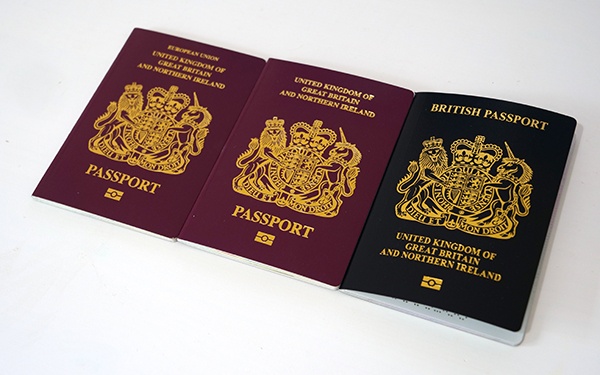Going abroad with your child for the first time is always an exciting (and sometimes challenging!) prospect — whatever their age.
One of the first things you’ll need to sort out before you go is getting their first child passport.
Don’t sit on this. It’s easy to put off anything that involves red tape and sending off forms but there can be delays and you don’t want to have to postpone your holiday just because you’re waiting on a passport.
Thankfully, it’s a simple process that you should be able to complete easily and quickly if you follow the steps. We’ll walk you through exactly what you need to do to apply for a first child passport.
Child Passport Facts
- You can apply for a child aged under 16 years
- You must have parental responsibility for the child you’re applying for
- Child must have British nationality
- Valid for 5 years
- £49 if you apply online
- £74.50 if you apply via the Post Office
- Can take up to 10 weeks

How To Apply For A First Child Passport
There are two ways to apply for a first child passport: either online or via a paper form at the Post Office.
It’s slightly cheaper to apply online and usually quicker.
Some people prefer the Post Office service as it means that your application is checked over before being sent for processing — and therefore is potentially less likely to be rejected on the grounds of missing paperwork or being incorrectly filled out.
Online
First things first, head to the government’s online passport service here.
What You’ll Need
- Digital passport photo
- Credit/debit card to pay fee of £49
- Supporting documents
- Details of a ‘digital referee’ to confirm your child’s identity

Digital Passport Photo
If you’ve got a very young child — i.e. a baby or a toddler — you’re probably thinking that it’s going to be next to impossible to get an ‘acceptable’ photo in a normal passport booth. You’re probably right.
Well, don’t worry — there are better options available.
Some shops offer specialist passport photo services for children and will be able to ensure that you get one that meets all the required standards. They will provide you with a code to directly add the photo to your online application.
Another option is to simply take the photo yourself using your smartphone or tablet.
You’ll need to make sure that the photo meets the following standards:
- Child must be on their own in the photo
- No toys or dummies should be visible
- Children under 6 do not have to look directly at the camera or have a neutral expression
- Children under 1 do not have to have their eyes open
- The child must be against a plain, light-coloured background. Top tip here is to simply lie them on a white sheet and take the photo from above.
The government page has more details on the required image quality (although this should be easily met by most modern smartphones).
You’ll need to upload your photo to your application.
Supporting Documents
Exactly what documents your child’s passport application will require will depend on a number of factors but generally you can expect the following:
- Full birth or adoption or registration certificate of the child
- Passport details of each parent or their birth certificates if passport details cannot be provided
- If applicable, the date of the parents’ marriage
- If applicable, grandparents’ documentation
- If applicable, details of any other valid passports from different countries belonging to the child
- If applicable, any court orders describing parental responsibility/residency arrangements that may be relevant to the application
The online passport service will tell you exactly which documents they require.
Please note that you will need to provide the true originals of the above documents. Copies — even certified ones — are not accepted.
Digital Referee
Once you’ve uploaded all the requested documentation and completed the application, the online passport service will ask for details of a digital referee that can confirm your child’s identity.
You’ll need their full name and email address, and they’ll be contacted by email — make sure you ask them before you start the application that they’re happy to act in this capacity for you!
A digital referee must:
- Have known you (the parent/guardian making the application) for at least 2 years
- Not be related to, in a relationship with, or living at the same address as the child or the applicant
- Be over 18 years old
- Live in the UK
- Have a current UK passport
The digital referee will be contacted and asked to confirm the identity of the child online and provide their details. They do not need to sign any printed photos.

Via The Post Office
If you’d prefer the comfort of a ‘check and send’ service, you can instead do a paper form with the Post Office instead, which they will personally check before sending it off for processing.
The
What You’ll Need
Assuming you’re going with the Paper Check & Send option, you’ll need the following before making your application:
- Completed passport application form (these can be picked up in any Post Office branch)
- 2 passport photos of your child (these need to be compliant as detailed above in the Online section, but obviously printed photos instead of digital)
- Supporting documents — the same as detailed above, including the full birth/adoption/registration certificate, passport details or birth certificates of the parents, and any other relevant documentation
- A countersignatory
While the online passport service will tell you exactly what supporting documents you’ll need to provide, you don’t have quite the same transparency with a paper application. Thankfully though, that’s what the ‘check and send’ service offers you — the Postmaster will tell you if you need to provide any further documentation and exactly what that is before you submit the application.
There’s also the option to pay an additional £5 which will ensure that the supporting documentation is posted back to you securely. We think this is a worthwhile add-on to make sure that nothing gets lost in the post!
Make sure that you use a black ballpoint pen to complete the application form and write in CAPITALS.
Take a look at the Post Office’s website to read more about the process.
Countersignatory
The countersignatory will be acting in the same role as the digital referee in the online application — that is, someone to confirm your child’s identity.
The countersignatory must:
- Have known you (the parent/guardian making the application) for at least 2 years
- Not be related to, in a relationship with, or living at the same address as the child or the applicant
- Be over 18 years old
- Live in the UK
- Have a current UK passport
They will need to sign the application form and the photos, confirming their identity.
If your child is aged over 12 years old, they will also need to sign the form.

Renewing A Child’s Passport
Renewing a child’s passport is usually much quicker and easier than applying for their first one.
Child passports are valid for 5 years although you need at least 6 months left on this to travel to many countries.
Any time left on the old passport won’t be transferred to their new one, so don’t renew too early.
You can either do it online or by post with the Post Office.
What You’ll Need
- Your child’s old passport
- A credit or debit card to pay the £49 fee if applying online (or £74.50 if applying via the Post Office)
- A digital passport photo of your child (if applying online) or 2 printed passport photos (if applying via the Post Office)
- Any valid passports from other countries
- Any relevant court orders describing parental responsibility
- A digital referee (online) or countersignatory (via the Post Office) to confirm their identity if they’re under 12 years old
A digital referee/countersignatory isn’t needed if your child is over 12 and can still be recognised by their photo in their old passport.
Replacing A Child Passport
If your child’s passport is lost, stolen or damaged, you’ll need to replace it.
This is much the same process as applying for a first one or renewing, as it can be done online or via the Post Office and costs the same amount. You shouldn’t need to provide all the supporting documentation this time around, however, although you’ll still need a digital referee or countersignatory.
If the passport is damaged, you’ll need to send in the damaged passport as well as a statement explaining how the damage occurred from whomever has parental responsibility.
Make sure to cancel the passport if it has been lost or stolen ASAP as this should stop anyone else using it fraudulently.

If Your Child Is Adopted Or Fostered
If either of the adoptive parents of your child is British and habitually resident in the UK, then they can get a British passport.
This applies to both children adopted within the UK and overseas — the latter assuming they were adopted after 1 June 2003 and according to the Hague Convention.
If the child in question is in foster care, you will need to contact the Passport Adviceline for individual advice.
What About If The Child Is Born Through Surrogacy?
You will need to provide a little extra documentation if your child was born through surrogacy.
As well as all the usual supporting documents, you’ll also need to provide:
- A letter detailing the surrogacy arrangement
- Evidence of surrogacy treatment
For more details on parental orders and children born outside the UK, please take a look at the government website.
What If They Were Conceived With A Sperm Donation?
You do not need to specify that your child was conceived through sperm donation, simply send in their birth certificate if they were born in the UK.
If the child was born overseas, different rules apply — see here or contact the Passport Advice line.

How Long Does It Take To Get A Child Passport?
The passport office recommend that you allow up to 10 weeks to receive your passport from the date of your application.
Truthfully, it’s best to apply with as much time as possible before you need to use it — the passport office are notorious for delays, particularly in the lead-up to the Summer holiday season. Don’t book travel abroad until you’ve received the passport.
Generally speaking though, you can expect a first child passport to take around 6 weeks.
Online applications tend to be speedier than paper ones via the Post Office, assuming that you don’t need to provide any extra documentation and everything else is in order.
Renewals are generally much quicker to process — around 3 weeks.
You can track your application online, whether you applied online or via the Post Office.
Your supporting documents should arrive first. Remember you can pay an extra £5 at the time of application to get them sent by secure delivery.
Your passport will then be delivered.
So that’s what you need to know about getting a child passport — do you have any tips to share?
Head over to our advice section for more tips on travelling with a toddler!

